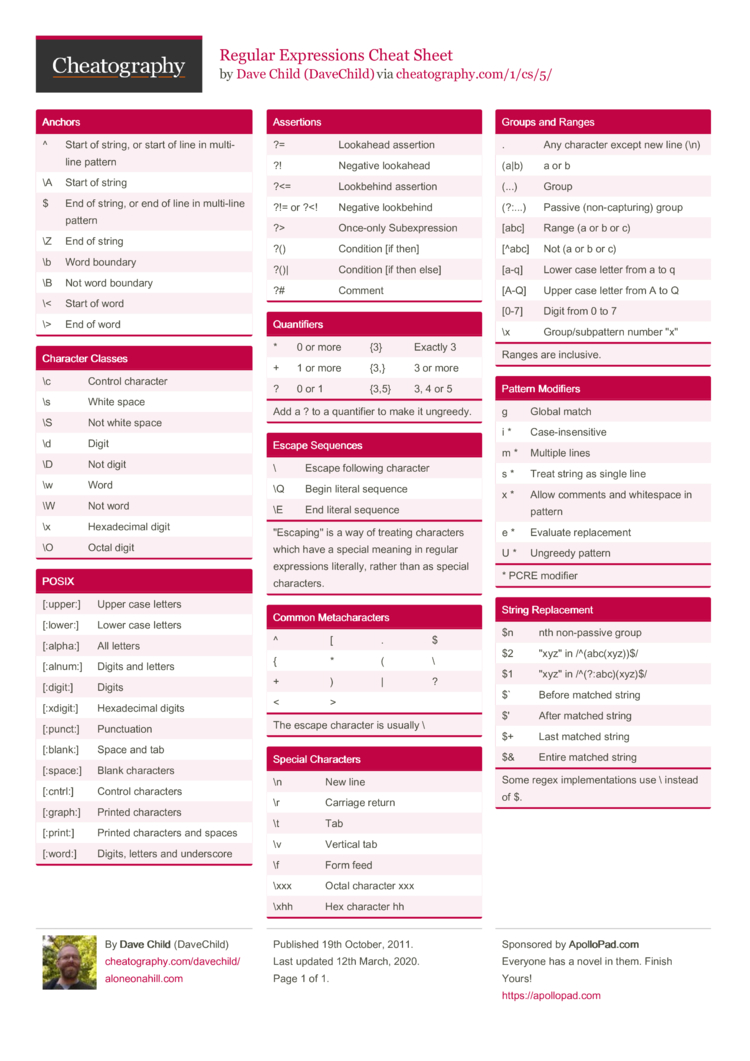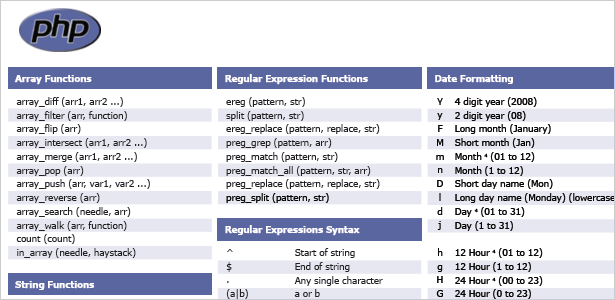- Python Regex Cheat Sheet Examples
- Regular Expression Tester
- Regex Python Cheet Sheet
- Regex Python Cheat Sheet Examples
- Regular Expression Cheat Sheet
You'll be able to study them slowly, and to use them as a cheat sheet later, when you are reading the rest of the site or experimenting with your own regular expressions. If you overdose, make sure not to miss the next page, which comes back down to Earth and talks about some really cool stuff: The 1001 ways to use Regex. RegExes syntax can be hard to recall. Check out our “Python RegEx Cheatsheet” to help point you in the right direction when building RegExes in Python. Regular Expressions with Python Regular Expressions Cheat Sheet Object Types - Lists Object Types - Dictionaries and Tuples Functions def,.args,.kargs Functions lambda Built-in Functions map, filter, and reduce Decorators List Comprehension Sets (union/intersection) and itertools - Jaccard coefficient and shingling to check plagiarism. Python Regular Expression's Cheat Sheet (borrowed from pythex) Special Characters. Escape special characters. Matches any character. ^ matches beginning of string. $ matches end of string. 5b-d matches any chars '5', 'b', 'c' or 'd'. ^a-c6 matches any char except 'a', 'b', 'c' or '6'. How to add a favicon to weebly (update). R S matches either regex R or regex.
Special characters
.Default: Match any character except newline.DOTALL: Match any character including newline^Default: Match the start of a string^MULTILINE: Match immediatly after each newline$Match the end of a string$MULTILINE: Also match before a newline*Match 0 or more repetitions of RE+Match 1 or more repetitions of RE?Match 0 or 1 repetitions of RE*?, *+, ??Match non-greedy as few characters as possible{m}Match exactly m copies of the previous RE{m,n}Match from m to n repetitions of RE{m,n}?Match non-greedyEscape special characters[]Match a set of characters|RE1|RE2: Match either RE1 or RE2 non-greedy(..)Match RE inside parantheses and indicate start and end of a groupWith RE is the resulting regular expression.Special characters must be escaped with if it should match the character literally
Methods of 're' module
re.compile(pattern,
flags=0)Compile a regular expression pattern into a regular expression object. Can be used with match(), search() and othersre.search(
pattern,
string,
flags=0Search through string matching the first location of the RE. Returns a match object or Nonere.match(
pattern,
string,
flags=0)If zero or more characters at the beginning of a string match pattern return a match object or
 Nonere.fullmatch(
Nonere.fullmatch(pattern,
string,
flags=0)If the whole string matches the pattern return a match object or Nonere.split(
pattern,
string,
maxsplit=0,
flags=0)Split string by the occurrences of patternmaxsplit times if non-zero. Returns a list of all groups.re.findall(
pattern,
string,
flags=0
 )Return all non-overlapping matches of pattern in string as list of strings.re.finditer(
)Return all non-overlapping matches of pattern in string as list of strings.re.finditer(pattern,
string,
flags=0)Return an iterator yielding match objects over all non-overlapping matches for the pattern in stringre.sub(
pattern,
repl,
string,
count=0,
flags=0)Return the string obtained by replacing the leftmost non-overlapping occurrences of pattern in string by the replacementrepl. repl can be a function.re.subn(
pattern,
repl,
string,
count=0,
flags=0)Like sub but return a tuple (new_string, number_of_subs_made)re.escape(
pattern)Escape special characters in patternre.purge()Clear the regular expression cache
Raw String Notation
In raw string notationr'text' there is no need to escape the backslash character again.>>> re.match(r'W(.)1W', ' ff ')<re.Match object; span=(0, 4), match=' ff '>>>> re.match('W(.)1W', ' ff ')<re.Match object; span=(0, 4), match=' ff '>Reference
https://docs.python.org/3/howto/regex.htmlhttps://docs.python.org/3/library/re.htmlExtensions
(?..)This is the start of an extension(?aiLmsux)The letters set the correspondig flags See flags(?:..)A non-capturing version of regular parantheses(?P<name>..)Like regular paranthes but with a named group(?P=name)A backreference to a named group(?#..)A comment(?=..)lookahead assertion: Matches if .. matches next without consuming the string(?!..)negative lookahead assertion: Matches if .. doesn't match next(?<=..)positive lookbehind assertion: Match if the current position in the string is preceded by a match for .. that ends the current position(?<!..)negative lookbehind assertion: Match if the current position in the string is not preceded by a match for ..(?(id/name)yes-pattern|no-pattern)Match with yes-pattern if the group with gived id or name exists and with no-pattern if notMatch objects
Match.expand(template)Return the string obtained by doing backslash substitution on template, as done by the sub() methodMatch.group(
[group1
 ,..])Returns one or more subgroups of the match. 1 Argument returns string and more arguments return a tuple.Match.__getitem__(
,..])Returns one or more subgroups of the match. 1 Argument returns string and more arguments return a tuple.Match.__getitem__(g)Access groups with m[0], m[1] ..Match.groups(
default=None)Return a tuple containing all the subgroups of the matchMatch.groupdict(
default=None)Return a dictionary containing all the named subgroups of the match, keyed by the subgroup name.Match.start(
[group
Python Regex Cheat Sheet Examples
]Match.end(
[group])Return the indices of the start and end of the substring matched by groupMatch.span(
[group])For a match m, return the 2-tuple
(m.start(group) m.end(group))Match.posThe value of pos which was passed to the search() or match() method of the regex objectMatch.endposLikewise but the value of endposMatch.lastindexThe integer index of the last matched capturing group, or None.Match.lastgroupThe name of the last matched capturing group or NoneMatch.reThe regular expression object whose match() or search() method produced this match instanceMatch.stringThe string passed to match() or search()Special escape characters
AMatch only at the start of the stringbMatch the empty string at the beginning or end of a wordBMatch the empty string when not at the beginning or end of a worddMatch any Unicode decimal digit this includes [0-9]DMatch any character which is not a decimal digitsMatch Unicode white space characters which includes [ tnrfv]SMatches any character which is not a whitespace character. The opposite of swMatch Unicode word characters including [a-zA-Z0-9_]WMatch the opposite of wZMatch only at the end of a stringRegular Expression Objects
Pattern.search(string[,
pos[,
endpos]])See
re.search()Regular Expression Tester
. pos gives an index where to start the search. endpos limits how far the string will be searched.Pattern.match(string[,
pos[,
endpos]])
Regex Python Cheet Sheet
Likewise but seere.match()Pattern.fullmatch(string[,
pos[,
endpos]])Likewise but see
re.fullmatch()Pattern.split(string,
maxsplit=0)Identical to
re.split()Pattern.findall(string[,
pos[,
endpos]])Similar to
re.findall() but with additional parameters pos and endposPattern.finditer(string
Regex Python Cheat Sheet Examples
[,pos[,
Regular Expression Cheat Sheet
endpos]])Similar tore.finditer() but with additional parameters pos and endposPattern.sub(repl,
string,
count=0)Identical to
re.sub()Pattern.subn(repl,
string,
count=0)Identical to
re.subn()Pattern.flagsThe regex matching flags.Pattern.groupsThe number of capturing groups in the patternPattern.groupindexA dictionary mapping any symbolic group names to group membersPattern.patternThe pattern string from which the pattern object was compiledThese objects are returned by the re.compile() methodFlags
ASCII, AASCII-only matching in w, b, s and dIGNORECASE, Iignore caseLOCALE, Ldo a local-aware matchMULTILINE, Mmultiline matching, affecting^ and $DOTALL, Sdot matches alluunicode matching (just in (?aiLmsux))VERBOSE, XverboseFlags are used in (?aiLmsux-imsx:..) or (?aiLmsux) or can be accessed with re.FLAG. In the first form flags are set or removed.This is useful if you wish to include the flags as part of the regular expression, instead of passing a flag argument to the re.compile() function

